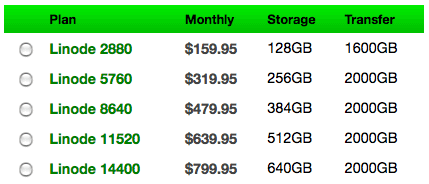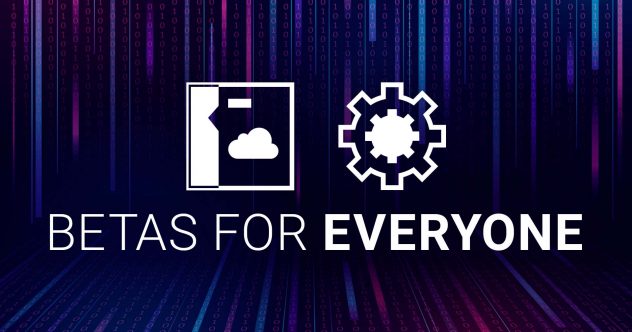Direkt nach unserem sechsjährigen Jubiläum freut sich Linode, eine größere Bandbreite an Skalierbarkeit mit erweiterten Service-Plänen anzukündigen! Diese höherwertigen Linodes waren bisher verfügbar - aber nur als individuelle Pläne. Jetzt sind sie für jeden verfügbar, sofort, über das Anmeldesystem:
Es ist erwähnenswert, dass diese Pakete genau wie alle anderen behandelt werden; Extras und alle jährlichen Rabattstrukturen gelten für diese, genau wie für unsere bestehenden Pläne. Wir können Sie auch mit einem einfachen Support-Ticket auf eines dieser Pakete upgraden, und alles wird wie immer tagesgenau berechnet.
Stellen Sie sich vor, die erste Person in Ihrem Block mit einer Linode 14400 zu sein! Viel Spaß!








Kommentare (35)
That’s no Linode.
Supersize me! Who could possibility buy one of these?
Who needs to buy a new desktop when you can just order a Linode 14400? I’d be interested to see what kind of people need this sort of power.
Maybe Slashdot should move to Linode!
Nice, but how much RAM per Linode on these?
@Techman224: Porn sites 🙂
The Linode 5760 has 5760 MB of RAM. The Linode 8640 has 8640 MB of RAM. And so on…
That’s just crazy cool. Linodes like this make a VPS more attractive to someone who wants a few really beefy machines (for, say, keeping your entire DB in RAM or something crazy like that) but still wants the flexibility a VPS (and Linode) provides.
OK, I have to ask, why doesn’t bandwidth keep going up with all of the other specs?
Holy sweet frack! I imagine the lights at Linode HQ must dim every time someone fires one of these bad boys up! 😉
Seems a tad expensive. There are some real good dedicated server providers in europe these days selling systems with 8gb of ram (quality hw from msi) 2tb disk and 2tb traffic for 70usd/m.
I personally have used both linode and the provider in question. Both are very reliable, when it comes to outages and network stability.
The only pro thing here is that you can scale easily.
Oh my… I’ve got all my geek cells overexcited 🙂
Why does the bandwidth level off after the 5760?
Awesome!
Do you provide the same discount if you purchase them in year blocks instead of monthly?
@Mike Causer: “extras and all annual discount structures apply” <– from the post
Regarding the monthly xfer capping off: There aren’t as many Linodes at this level to play the bandwidth usage aggregation game, therefore we’re not taking chances.
How many of those mega slices per box ?
I’m already the only one on my block with a linode… and it’s a 360. That’s the price of living out in the middle of nowhere 😉
I assume these are all only 64-bit OS’, right.
Seems kind of pointless to offer this to the 32-bit OS offering since 3.2GB is the max a 32-bit OS can address
@Tim: Linode offers both 32 and 64 bit kernels and most distributions in both flavors. Linux 32 bit with PAE enabled (which our kernels are) can address up to 64GB of memory, however each process can only address 4GB at a time. So, the choice is still yours: 32 bit or 64 bit, even at these memory levels.
@caker: Thanks. Also, at these sizes – hard disk capacity is huge. Is that local disk or NAS/SAN/etc..?
Also, any update on the Linode backup system?
@Tim: disks are directly attached, raid10. Backups are in beta in all four facilities.
@caker: Awesome. Any word on when Backups will come out of Beta and will be available for all of us to use
@Tim: when it’s ready. 🙂
@caker: Can I get then just a vague idea of the time frame. E.g., this year, next year, etc…
Excellent!
I could think of many uses for these, but the price seems a bit high from the European perspective.
Maybe 3920/176/2000 with 159.95 would fit the dedicated competition well. 🙂
@caker: What’s to stop me from buying a Linode 2880 and paying $799.90 to use 8,000GB of bandwidth?
Or, what’s to stop me from just buying five Linode 2880s and getting an aggregate 1440MB of RAM, 640GB of storage space, and 8000GB of bandwidth?
@Guspz: I’m sure caker would be over joyed if you purchased 5 Linode 2880s in order to try to get over on him!
Go for it! 🙂
@Guspz: Could it simply be that the NIC simply can’t handle that much throughput if all used the max
@tim: 8000GB/mth is an average of 24mbit/s. Even doubling or tripling that for peak wouldn’t matter.
You’d have to have Linode hosts on a 10mbit NIC for it to be an issue…
@Guspaz
BUT, you’re forgetting that you’re not alone on the box.
At the 5760 level, which is where the bandwidth caps, here are the numbers
If Linode is using 16 GB of RAM servers:
– You’ll have 3 people total on the box, which translates to peak demand for all customers of 6000 GB of traffic which would equate to 18mbit/s
If Linode is using 32 GB of RAM servers:
– You’ll have 6 people total on the box, which translates to peak demand for all customers of 12000 GB of traffic which would equate to 36mbit/s
If Linode is using 64 GB of RAM servers (most likely)
– You’ll have 12 people total on the box, which translates to peak demand for all customers of 24000 GB of traffic which would equate to 72mbit/s
It’s a quality of service level for ALL customers.
Linode doesn’t oversell on anything.
You should be happy that they cap memory bandwidth.
That was one of the fears I had when I chose Linode over “it’s main competitor”. I feared that I could one day outgrow what Linode had to offer.
Now I feel pretty safe and do not regret my choice!
You rock, Linode!
Excellent. Another very good move.
I am wondering if these are the virtual machines.. what are the host servers like!?!
I’m just curious as you didn’t update the FAQ about this.
How many Linode’s are put on each node in these cases?
@Tim: Still not seeing the problem. 72mbit is well below the gigabit that most VPS hosts connect their host boxes to their network with. Peak throughput shouldn’t be a concern here. After all, how would 12×5760 (24TB per box) be as risky as 23×2880 (37TB per box)?
This is very important when it comes to government grant writing. In a lot of research areas you are not allowed to buy hardware, lab equipment, or anything that the government could physically own because when the grant runs out it has to go to the government. Now researchers can get huge computing power without “owning” the hardware behind it.
I realize that other computing services are available that researchers could use but I don’t think any other service offers as much bang per buck.
C. S. Mark